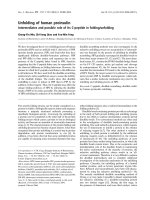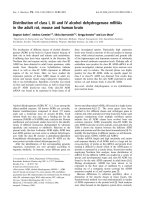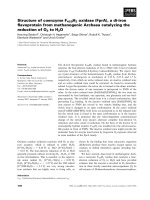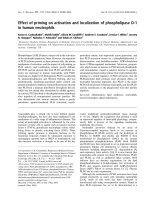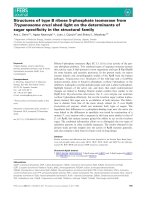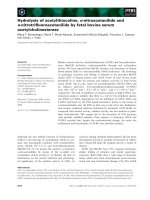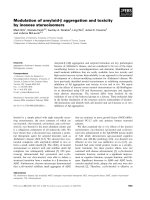báo cáo khoa học: " Seroprevalence of select bloodborne pathogens and associated risk behaviors among injection drug users in the Paso del Norte region of the United States – Mexico border" ppt
Bạn đang xem bản rút gọn của tài liệu. Xem và tải ngay bản đầy đủ của tài liệu tại đây (295.38 KB, 9 trang )
BioMed Central
Page 1 of 9
(page number not for citation purposes)
Harm Reduction Journal
Open Access
Research
Seroprevalence of select bloodborne pathogens and associated risk
behaviors among injection drug users in the Paso del Norte region
of the United States – Mexico border
Joan P Baumbach*
1
, Lily N Foster
1
, Mark Mueller
1
, Michelle Firestone Cruz
2
,
Sonia Arbona
3
, Sharon Melville
3
, Rebeca Ramos
4
and Steffanie A Strathdee
5
Address:
1
New Mexico Department of Health, Santa Fe, NM, USA,
2
Centre for Addiction and Mental Health, Toronto, ON, Canada,
3
Texas
Department of State Health Services, Austin, TX, USA,
4
United States – Mexico Border Health Association, El Paso, TX, USA and
5
University of
California, San Diego, CA, USA
Email: Joan P Baumbach* - ; Lily N Foster - ; Mark Mueller - ;
Michelle Firestone Cruz - ; Sonia Arbona - ;
Sharon Melville - ; Rebeca Ramos - ; Steffanie A Strathdee -
* Corresponding author
Abstract
Background: The region situated where the borders of Mexico, Texas and New Mexico meet is
known as 'Paso del Norte'. The Paso del Norte Collaborative was formed to study the
seroprevalence of select pathogens and associated risk behaviors among injection drug users
(IDUs) in the region.
Methods: Respondent-driven sampling (RDS) was used: 459 IDU participants included 204 from
Mexico; 155 from Texas; and 100 from New Mexico. Each of the three sites used a standardized
questionnaire that was verbally administered and testing was performed for select bloodborne
infections.
Results: Participants were mostly male (87.4%) and Hispanic/Latino (84.7%) whose median age
was 38. In Mexico, Texas and New Mexico, respectively: hepatitis B virus (HBV) was seen in 88.3%,
48.6% and 59.6% of participants; hepatitis C virus (HCV) in 98.7%, 76.4% and 80.0%; human
immunodeficiency virus (HIV) in 2.1%, 10.0% and 1.0%; and syphilis in 4.0%, 9.9% and 3.0%. Heroin
was the drug injected most often. More IDUs in New Mexico were aware of and used needle
exchange programs compared with Texas and Mexico.
Conclusion: There was mixed success using RDS: it was more successfully applied after
establishing good working relationships with IDU populations. Study findings included similarities
and distinctions between the three sites that will be used to inform prevention interventions.
Introduction
The 'Paso del Norte' region (See Figure 1) straddles the
midpoint of the U.S-Mexico border. It contains Ciudad
Juárez in Chihuahua, Mexico, El Paso, Texas and Doña
Ana County, New Mexico. It is a suitable site for the study
of risk behaviors associated with injection drug use
because: a) many people there lead lives on both sides of
the border; b) there are known injection drug use (IDU)
Published: 16 November 2008
Harm Reduction Journal 2008, 5:33 doi:10.1186/1477-7517-5-33
Received: 13 March 2008
Accepted: 16 November 2008
This article is available from: />© 2008 Baumbach et al; licensee BioMed Central Ltd.
This is an Open Access article distributed under the terms of the Creative Commons Attribution License ( />),
which permits unrestricted use, distribution, and reproduction in any medium, provided the original work is properly cited.
Harm Reduction Journal 2008, 5:33 />Page 2 of 9
(page number not for citation purposes)
Area map of Paso del Norte RegionFigure 1
Area map of Paso del Norte Region.
Harm Reduction Journal 2008, 5:33 />Page 3 of 9
(page number not for citation purposes)
populations in the three separate states involved; c) the
populations in these states are managed by different pro-
grams and policies.
Ciudad Juárez had an estimated population of 1.2 million
people in 2000 [1], 60% of which originate from other
parts of Mexico. The transient population is estimated at
250,000 persons [2,3]. After Tijuana in Baja California,
Ciudad Juárez is thought to have the largest population of
illicit drug users in Mexico, estimated to be twice that of
the national average [4]. In 2001, a community-based sur-
vey found that there were approximately 6,000 IDUs in
Juárez [5]. According to the U.S. Census Bureau, El Paso
County in Texas had 679,622 inhabitants in 2000 of
which 563,662 lived in the city of El Paso. The Texas
Department of State Health Services (DSHS) is an agency
of the Texas Health and Human Services System whose
mission is to improve health and well-being in Texas: one
statewide indicator is that 26% of the 88,452 admissions
to DSHS-funded treatment programs in 2007 had a his-
tory of IDU [6]. In 2000, according to the U.S. Census
Bureau, 174,682 persons lived in Doña Ana County, New
Mexico, of whom 74,267 lived in Las Cruces. The esti-
mated IDU population for 2003 was approximately
1,400. This estimate was derived from the National Survey
on Drug Use and Health and local indicator data (i.e.,
rates of drug-related death and infectious disease inci-
dence) (N. Shah; New Mexico Department of Health,
written communication; October 2005). There have been
relatively few studies of bloodborne infections among
IDUs in the Paso del Norte region. However, in 2006, in
the jurisdiction of Juárez, El Paso County and Doña Ana
County, newly reported rates of human immunodefi-
ciency virus (HIV) among all risk groups were 6.5 (G Bar-
rios Gallegos, State Epidemiologist, Chihuahua, Mexico,
written communication, September, 2007), 8.0 [7] and
2.5 per 100,000 (K Rooney, Epidemiologist, New Mexico
Department of Health, written communication; Septem-
ber, 2007), respectively. In a series of seroprevalence stud-
ies using convenience sampling conducted in Texas,
hepatitis C virus (HCV) seroprevalence for IDUs entering
drug treatment centers was 84.5%; 15% for IDUs tested
from sexually transmitted disease (STD) clinics, and
29.2% for IDUs at HIV testing sites [8]. Data from HIV
counseling and testing sites in El Paso revealed that 2.8%
of IDUs in those settings were positive for HIV between
2003 and 2006 (J Hitt; Texas DSHS HIV Prevention Pro-
gram Counseling and Testing Data, written communica-
tion; September, 2007). Seroprevalence results obtained
during studies of convenience samples of IDUs in New
Mexico in 1995 and 1997 revealed high rates of antibody
positive for HCV (82.2%) and hepatitis B virus (HBV)
(61.1%) and a low rate for HIV (0.5%): 90% of the IDUs
reported sharing injection equipment, 52% with friends
and 30.9% with their main sex partner [9]. While these
studies demonstrated associations between infection with
HBV and HCV and certain risk behaviors, methodological
limitations of convenience sampling were noted [10].
The question of how to reduce the risk of bloodborne dis-
ease transmission among IDUs in this region raises inter-
esting issues for consideration. Harm reduction is a fairly
new concept in Mexico and one that has often been met
with controversy by government. The first needle
exchange program in Mexico started in the 1980s in Juá-
rez, Chihuahua and is operated by Programa Com-
pañeros, A.C. [11,12], a non-governmental organization
that began in 1986 to assist individuals living with HIV/
AIDS and drug addictions: Programa Compañeros pro-
vides a number of prevention, treatment and social serv-
ices, including street and prison-based harm reduction
programs. The second needle exchange program in Mex-
ico opened in Tijuana, Baja California, in 2004 and is
operated by Prevencasa A.C. In addition, there are cur-
rently small-scale needle exchange programs operating in
five other states: Coahuila, Nuevo Leon, Oaxaca, Sinaloa
and Zacatecas [13]. In El Paso County, Texas, DSHS has
provided substance abuse treatment since 1980 through
its treatment center, Aliviane. In addition it provides pre-
vention education, counseling, testing for HIV and refer-
rals for treatment of infectious diseases and other health
problems. The seroprevalence and risk behavior results of
New Mexico studies from the mid 1990s [9] were used to
support the successful implementation by the New Mex-
ico Department of Health of a syringe exchange policy
enacted by the New Mexico Legislature in 1998. Since
then, over 10,000 individuals have enrolled in the Syringe
Exchange Program with nearly seven million syringes col-
lected and distributed statewide (B. Lieving, New Mexico
Department of Health, written communication; May,
2007).
The Paso del Norte Collaborative, comprised of govern-
mental public health workers, health services providers,
non-governmental organizations and academicians, was
formed in order to learn more about the IDU population
in the region. This paper focuses on the seroprevalence of
bloodborne infectious diseases and select associated risk
behaviors derived from the Paso del Norte Collaborative
study.
Methods
Respondent-driven sampling
The study was designed to be representative of the general
IDU population in the Paso del Norte region. To that end,
respondent driven sampling (RDS) was used. RDS is a
modified form of chain-referral sampling that relies on
members of a hidden population, such as IDUs, to recruit
their peers. Since its initial implementation to study IDUs
in several small Connecticut cities [14], RDS has been
Harm Reduction Journal 2008, 5:33 />Page 4 of 9
(page number not for citation purposes)
evaluated and proven an effective way to study hidden
populations, particularly those that are at risk for HIV
infection [15-19]. RDS has been used in several settings
that include large urban centers [20,21], smaller cities
[14,22], and mostly non-urban areas [23]. RDS attempts
to eliminate sampling bias by selection of initial respond-
ents called 'seeds' who have diverse gender, race/ethnicity,
and drug preferences. This is an attempt to reach what is
termed homophily (i.e., the tendency for an individual
seed to recruit persons who are similar) in different
recruitment waves, each of which start from the seeds who
were recruited for their specific characteristics: the goal is
to arrive at a representative sample. However, limitations
in this sampling method certainly can include biases, par-
ticularly those that might lead to a more homogeneous
group of participants ultimately recruited than a truly rep-
resentative sample of the general IDU population in a
given geographic area.
In this study, a diverse group of seeds who were current
IDUs were recruited to initiate the process: they were het-
erogeneous in age, gender, race/ethnicity and drug/s of
choice. Each seed was enrolled into the study and pro-
vided with three uniquely coded coupons to refer to their
peers. Each peer enrolled into the study was also provided
three uniquely coded coupons. In all three sites, partici-
pants received modest monetary reimbursement for their
own enrollment into the study and if they returned for
laboratory results. In New Mexico and Texas, participants
received additional modest monetary reimbursement for
each recruit successfully enrolled into the study. RDS was
used to recruit 205 and 155 subjects in Juárez and El Paso,
respectively, while New Mexico recruited 83 subjects by
RDS and 17 were a convenience sample.
Study population and sites
In each study site, participants eligible for the study were:
a) 18 years or older; b) English or Spanish speaking; c)
active IDUs defined as having had at least one injection in
the past thirty days as demonstrated by injection stigmata
(i.e. skin 'track' marks) or clear ability to describe injection
drug methods and habits; d) willing and able to provide
written informed consent; and e) not previously inter-
viewed for the study. Study participants were not aware of
the eligibility requirements so as not to bias ongoing
recruitment. Data collection occurred between February-
March 2005 in Ciudad Juárez, January-March 2005 in
Doña Ana County and February-August 2006 in El Paso.
Enrollment and questionnaire
The study process included: a) a screening using specific
inclusion criteria; b) a blood draw; c) a questionnaire
administered verbally in English or Spanish; d) medical
oversight by licensed physicians; e) exit procedures that
included provision of prevention information, referrals to
services and distribution of coupons to be given to subse-
quent recruits from their social network; f) return of par-
ticipants for laboratory results. Participants at the New
Mexico site were able to receive hepatitis A and/or B vac-
cination if indicated by laboratory results. Hepatitis A and
B vaccines were available to all participants enrolled in the
Texas site. Study methods were approved by the Institu-
tional Review Boards of the three respective areas.
Each of the three sites used a standardized questionnaire
that was verbally administered by trained study workers.
Most questions had been previously validated: those that
had not were piloted in English and Spanish prior to
implementation of the study. New Mexico and Texas used
identical questionnaires which represented a subset of the
questions used in Mexico. Cultural sensitivity and non-
judgmental approaches were stressed during training of
the study workers and throughout the study. The survey
included questions on: a) demographics; b) social net-
work size and relationship to the person from whom cou-
pon was received (these questions are needed for RDS
calculations); c) socioeconomics (e.g., marital status, liv-
ing sites, average monthly income, sources of income,
ever incarcerated); d) injection drug use and needle shar-
ing behavior; e) sexual behavior; f) infectious disease his-
tory; g) health services and insurance coverage.
Laboratory testing
The New Mexico Department of Health Scientific Labora-
tory Division (SLD) conducted all testing for the New
Mexico and Mexico participants who supplied sufficient
quantity of serum. Testing for hepatitis A virus (HAV) was
performed on specimens collected in New Mexico but not
in Mexico: in addition, both sites had tests for HIV-1,
HBV, HCV and syphilis. Specimens collected in Texas
were tested by the Texas DSHS laboratory in Austin, Texas.
A few specimens were tested for HIV-1 at the El Paso City-
County Health and Environmental District Laboratory.
All Centers for Disease Control and Prevention (CDC)
permits and customs documents were completed accord-
ing to government standards. Confirmed HIV positive
specimens from Mexico were also sent to the Institute of
Human Virology, University of Maryland Biotechnology
Institute for viral sequencing.
For New Mexico specimens, HIV-1 antibody testing was
conducted using an enzyme-linked immunosorbent
assay, the Vironostika HIV-1 Microelisa System (bioMer-
ieux, Inc., Durham, NC). Specimens that were repeatedly
reactive were further tested by the Genetic Systems HIV-1
Western Blot assay (Bio-Rad Laboratories, Inc., Hercules,
CA). For Mexico specimens, a drop of blood from each
sample was used in the Determine
®
HIV-1/2 Test (Abbott
Laboratories, Kampala, Uganda); this rapid test is
approved for developing countries. The remainder of clin-
Harm Reduction Journal 2008, 5:33 />Page 5 of 9
(page number not for citation purposes)
ical specimens from Mexico was sent to DSHS in El Paso
and from there to SLD for the remainder of testing. Hepa-
titis testing was conducted using a number of enzyme
immunoassays: for HAV, ETI-AB-HAVK PLUS (DiaSorin,
Inc., Stillwater, MN); for hepatitis B core antibody (anti-
HBc), ETI-AB-COREK PLUS (DiaSorin, Inc., Stillwater,
MN); for hepatitis B surface antigen (HBsAg), Genetic Sys-
tems HBsAg EIA 3.0 (Bio-Rad Laboratories, Inc., Hercules,
CA); for HCV, Ortho HCV Version 3.0 ELISA (Ortho-Clin-
ical Diagnostics, Rochester, NY). Syphilis screening was
done using the Impact Rapid Plasma Reagin (RPR) Card
Test (Inverness Medical, Princeton, NJ) and confirmed by
a Treponema pallidum particle agglutination (TP PA) test,
the Serodia-TP PA kit (Fujirebio Diagnostics, Inc., Mal-
vern, PA). With the exception of the tests for HBsAg and
initial syphilis screening, the DSHS laboratory used the
same tests as SLD. Testing for HBsAg was done using ETI-
MAK-2 PLUS (DiaSorin, Inc., Stillwater, MN). Screening
for syphilis was conducted by the ASI RPR 18 mm Card
Test (Arlington Scientific, Inc., Springville, UT); reactive
specimens were confirmed by the Serodia-TP PA kit
(Fujirebio Diagnostics, Inc., Malvern, PA).
Given the requirements for anonymity and the highly
mobile nature of the participants, care was taken to advise
participants in the study of when and where to return for
their laboratory results. In order to obtain results, partici-
pants provided key information that linked to the unique
codes submitted with their clinical specimens.
Statistical analysis
Demographics of the study population, rates of select
bloodborne infections (i.e., HAV, HBV, HCV, HIV and
syphilis), and some associated risk behaviors were ana-
lyzed to provide a basic description of this IDU popula-
tion. Data was collected on site using Microsoft Excel
(Microsoft, Redmond, WA) and later merged and ana-
lyzed using SAS version 9.1 (SAS Institute Inc, Cary, NC).
All categorical variables – including sociodemographic
and risk behavior information – were compared across the
three sites using the Chi-square test of independence. In
the case of small numbers, Fisher's Exact method was
employed to detect significant differences across sites. The
continuous variables of age, years of education, social net-
work size and days since last injection were compared
across sites using one-way analysis of variance (ANOVA)
methods.
Crude seroprevalence was calculated by observing the
number of blood samples that tested positive out of the
total number of samples that could be processed given
adequate quantity and quality of clinical specimens. RDS
seroprevalence adjustments for the Texas and Mexico data
were calculated using the RDS Analysis Tool v.5.6.0 (Cor-
nell University, 2003). New Mexico was unable to utilize
RDS analytic tools because of the number of study partic-
ipants who were recruited as seeds or convenience sam-
ples and also because recruitment patterns were not
heterologous enough for a number of traits (e.g., those
who were hepatitis A positive only recruited others who
happened to be hepatitis A positive). Without more cross-
recruitment, RDS adjustments cannot be calculated [24].
Results
Demographic and social characteristics
Of the 459 study participants, 204 were from Ciudad Juá-
rez, 155 from El Paso and 100 from Doña Ana County.
Overall, 401 (87.4%) were male and 58 (12.6%) were
female (Table 1). The median age was 38 years (33 years
in Mexico and 42 years in both Texas and New Mexico).
Information was available from 456 respondents on eth-
nicity: 389 (84.7%) identified as Hispanic/Latino and 67
(14.6%) as not Hispanic/Latino. Education status was
expressed as number of years of education completed and
the overall median was 9 years: 7 in Mexico, 11 in Texas
and 11.5 in New Mexico, respectively.
Median social network size ("How many people do you
know by name or street name in the past six months who
also shoot up?") was 20: median sizes were 20 in Mexico,
14 in Texas and 10 in New Mexico. Only 251 (54.7%) par-
ticipants overall reported no family members ever inject-
ing drugs.
Seroprevalence
Testing for HAV was conducted in New Mexico and Texas.
Using RDS, 73% of Texas IDUs had evidence of HAV com-
pared with New Mexico's crude finding among 66% of
participants (Table 2). Hepatitis B testing was done at all
3 study locations: RDS calculations revealed that Mexico
had 88.3% and Texas 48.6% of IDUs positive for anti-
HBc, revealing individuals who were not susceptible to
infection (i.e., immune due to natural infection whether
acute infection or chronically infected), compared with
New Mexico's crude calculation of 59.6%. RDS calcula-
tions for HCV revealed that 98.7% screened positive in
Mexico and 76.4% in Texas compared with New Mexico's
crude calculation of 80.0%. RDS calculations for propor-
tion of individuals who were HIV-positive revealed 2.1%
for Mexico, 10.0% for Texas and a crude 1.0% for New
Mexico. Syphilis was seen among 4.0% of participants in
Mexico and 9.9% in Texas using RDS calculations com-
pared with New Mexico's crude calculation of 3.0%.
Risk behaviors
Injection drug habits were different between sites with a
higher percent (97.1%) of respondents in Mexico report-
ing injecting at least daily in the past six months com-
pared with 64.5% and 55.0% in Texas and New Mexico,
Harm Reduction Journal 2008, 5:33 />Page 6 of 9
(page number not for citation purposes)
Table 1: Demographic and social characteristics of study participants
Doña Ana County, NM
(n = 100)
Ciudad Juárez, MX
(n = 204)
El Paso, TX
(n = 155)
Chi-square
p-value
a
All sites
(n = 459)
Sex, n (%)
Male 80 (80.0) 189 (92.7) 132 (85.2) 401 (87.4)
Female 20 (20.0) 15 (7.4) 23 (14.8) 0.005 58 (12.6)
Age. mean (median) 41.8 (42.0) 35.3 (33.0) 42.0 (42.0) < 0.0001
b
39.0 (38.0)
Hispanic, n (%)
Yes 69 (69.0) 203 (99.5) 117 (75.5) 389 (84.7)
No 31 (31.0) 1 (0.5) 35 (22.5) < 0.0001 67 (14.6)
No answer 0 (0.0) 0 (0.0) 3 (1.9) 3 (0.7)
Country of birth, n (%)
USA 94 (94.0) 4 (2.0) 139 (89.7) 237 (51.6)
Mexico 4 (4.0) 200 (98.0) 14 (9.0) 218 (47.5)
Other 1 (1.0) 0 (0.0) 1 (0.6) 2 (0.4)
No answer 1 (1.0) 0 (0.0) 1 (0.6) 2 (0.4)
Years of education, mean (median) 10.9 (11.5) 7.1 (7.0) 10.8 (11) < 0.0001
b
9.2 (9.0)
Marital status, n (%)
Unmarried 41 (41.0) 105 (51.5) 66 (42.6) 212 (46.2)
Married 27 (27.0) 62 (30.4) 36 (23.2) 125 (27.2)
Divorced/Separated/Widowed 32 (32.0) 36 (17.6) 52 (33.5) 0.007 120 (26.1)
No answer 0 (0.0) 1 (0.5) 1 (0.6) 2 (0.4)
Social network, mean (median) 21.0 (10.0) 52.2 (20.0) 28.5 (15.0) 0.002
b
37.4 (20.0)
Days since last injection, mean (median) 5.2 (2.0) 0.8 (0.0) 3.7 (1.0) < 0.0001
b
2.7 (1.0)
Family ever inject drugs*, n (%)
None 49 (49.0) 118 (57.8) 84 (54.2) 251 (54.7)
Mother/father 10 (10.0) 12 (5.9) 13 (8.4) 35 (7.6)
Sibling 40 (40.0) 49 (24.0) 51 (32.9) 140 (30.5)
Cousin 12 (12.0) 17 (8.3) 18 (11.6) 47 (10.2)
Aunt/uncle 17 (17.0) 15 (3.3) 22 (14.2) 54 (11.8)
Other 11 (11.0) 24 (5.2) 20 (12.9) 55 (12.0)
Don't know 2 (2.0) 2 (0.4) 4 (2.6) 8 (1.7)
Ever have tattoo
Yes 80 (80.0) 167 (81.9) 119 (76.8) 366 (79.7)
No 20 (20.0) 37 (18.1) 33 (21.3) 0.702 90 (19.6)
No answer 0 (0.0) 0 (0.0) 3 (1.9) 3 (0.7)
*Categories are not mutually exclusive and therefore percentages may be greater than 100%.
a
Chi-square test of independence used to observe differences in categorical variables across sites.
b
ANOVA used to compare means across sites.
Table 2: Crude and RDS-adjusted seroprevalence of infectious diseases among study participants
Doña Ana County, NM Ciudad Juárez, MX El Paso, TX Crude %
p-value
Positive Total* Crude % RDS % Positive Total Crude % RDS % Positive Total Crude % RDS %
HAV 66 97 68.0 - - - - - 105 148 70.9 73.0 0.740
a
HBV 56 94 59.6 - 171 203 84.2 88.3 74 137 54.8 48.6 < .0001
b
HCV 76 95 80.0 - 194 203 95.6 98.7 122 147 83.0 76.4 < .0001
a
HIV 1 100 1.0 - 6 203 3.0 2.1 9 155 5.8 10.0 0.109
b
Syphilis 3 100 3.0 - 7 193 3.6 4.0 8 150 5.3 9.9 0.605
a
*Total excludes participants whose sample was either insufficient or rejected for testing.
a
Chi-square test of independence used to observe differences among crude seroprevalence across sites.
b
Fisher's Exact method used to run test of independence due to > 20% of cells with less than 5 observations.
Harm Reduction Journal 2008, 5:33 />Page 7 of 9
(page number not for citation purposes)
respectively (p < 0.0001) (Table 3). Heroin alone was the
drug injected most often in the past six months in New
Mexico (69.0%) and Texas (66.5%), whereas in Mexico
the 'speedball' or combination of heroin and cocaine was
the most frequently injected (41.3%) in the past six
months (p < 0.0001). More respondents in Mexico
(64.7%) and Texas (62.6%) reported using previously
used needles in the past six months compared with New
Mexico respondents (38.0%) (p < 0.0001). More respond-
ents in New Mexico (71.0%) were aware of needle
exchange programs in their area compared with Mexico
(14.2%) and Texas (11.0%) (p < 0.0001). Numbers of
participants who answered questions about awareness
and use of needle exchange programs in the previous six
months were relatively low. Of all sites combined, 57.7%
(71/123) reported being aware of needle exchange and
had used a program in the past six months: 68.4% (52/
76) in Doña Ana County; 58.6% (17/29) in Ciudad Juá-
rez; 11.1% (2/18) in El Paso.
Discussion
These findings from the Paso del Norte Collaborative
study describe a group of IDUs who are mainly Hispanic/
Latino, male (87.4%), with a median age of 38, relatively
poorly educated (median years of education 9), who have
relatively high rates of infectious hepatitis and much
lower rates of HIV and syphilis. The median age and gen-
der characteristics of the IDU population in this study
were similar to those seen in other studies of seropreva-
lence among IDUs [25,26]. While the demographics of
the IDU population studied were similar, some findings
were site-specific: a) mean social network size of Mexico
participants was larger than in Texas, which in turn was
larger than in New Mexico; b) participants from Mexico
injected more frequently than those from Texas or New
Mexico; c) while Texas had much lower rates of HBV and
HCV than Mexico and slightly lower rates than New Mex-
ico, they had higher rates of HIV and syphilis. The com-
mon and site-specific findings in this study will enable
those working in the region to design and implement
services for their populations more precisely.
New Mexico participants reported being aware of and
using needle exchange programs in their area more than
reported at the other two sites. Overall, there were high
rates of injection drug use seen in families, including
inter-generational findings. The Mexico site reported
larger social network sizes and more frequent injection
drug use behavior, factors which have been studied in the
context of transmission of HBV, HCV and HIV [27-30].
The higher rates of HIV and syphilis among Texas resi-
dents compared with Mexico and New Mexico were not
matched by their rates of HBV and HCV, both of which
were much lower than those of Mexico and slightly lower
than New Mexico.
There were a number of limitations of the study. The total
number of study participants was less than optimal. New
Table 3: Risk behaviors among study participants
Doña Ana County, NM
(n = 100)
Ciudad Juárez, MX
(n = 204)
El Paso, TX
(n = 155)
Chi-square p-value
a
All sites
(n = 459)
In the past 6 months, how often did you inject
drugs?
Less than daily 43 (43.0) 5 (2.5) 49 (31.6) 97 (21.1)
Several times a day 55 (55.0) 198 (97.1) 100 (64.5) < 0.0001 353 (76.9)
No answer 2 (2.0) 1 (0.5) 6 (3.9) 9 (2.0)
In the past 6 months, how often have you used a
needle that you knew had been used before?
Never 60 (60.0) 71 (34.8) 14 (9.0) 145 (31.6)
Share 38 (38.0) 132 (64.7) 97 (62.6) < 0.0001 267 (58.2)
No answer 2 (2.0) 1 (0.5) 44 (28.4) 47 (10.2)
Are you aware of any needle exchange programs in
your area?
No 29 (29.0) 174 (85.3) 135 (87.1) 338 (73.6)
Yes 71 (71.0) 29 (14.2) 17 (11.0) < 0.0001 117 (25.5)
No answer 0 (0.0) 1 (0.5) 3 (1.9) 4 (0.9)
Which of the following drugs do you inject most
often in the past 6 months?
Heroin 69 (69.0) 82 (40.2) 103 (66.5) 254 (55.3)
Cocaine 17 (17.0) 4 (2.0) 29 (18.7) 50 (10.9)
Speedball (heroin + cocaine) 2 (2.0) 84 (41.2) 14 (9.0) 100 (21.8)
Other 5 (5.0) 10 (4.9) 6 (3.9) < 0.0001 21 (4.6)
No answer 7 (7.0) 24 (11.8) 3 (1.9) 34 (7.4)
a
Chi-square test of independence used to observe differences across sites.
Harm Reduction Journal 2008, 5:33 />Page 8 of 9
(page number not for citation purposes)
Mexico recruited fewer than 10% of the projected IDU
population in Doña Ana County. Texas and New Mexico
used significantly more seeds than Mexico. New Mexico
enrolled 17% of participants as a convenience sample
because of slow enrollment. In addition, for a number of
traits among New Mexico participants, recruitment pat-
terns were insular. These limitations in the New Mexico
sample precluded RDS analysis thereby making a tri-state
binational aggregated RDS analysis impossible. Although
Texas recruited a similar number of seeds as New Mexico,
their sample characteristics allowed for RDS calculations.
Another limitation is that data collection did not occur
during the same time frame for the three sites.
One of the strengths of the Paso del Norte Collaborative
study was the unified approach toward the development
of methods, training of study workers, implementation of
the study and analysis of data. All three sites contributed
to decision-making. Individuals from the three study sites
visited each other as training was being conducted for
study workers and again as the study was rolled out in
phases: lessons learned were shared throughout the study.
The same database shell was used for on-site management
of questionnaires completed, coupons distributed, and
distribution of laboratory results and modest monetary
reimbursements. Representatives from each site per-
formed quality control of data. Data-sharing agreements
were formalized which include review of quality and
interpretation of data by named representatives from all
three sites.
Conclusion
This first report of select findings from the Paso del Norte
Collaborative study provides baseline information that
can help local public health systems develop programs
and policies aimed at reducing the harms associated with
injection drug use and contribute to future studies to pre-
vent and control injection drug use and related transmis-
sion of bloodborne pathogens in this region. Although, in
general, there was mixed success using RDS, in Mexico,
where a non-governmental organization had achieved
longstanding trust in the IDU community, RDS worked
very well compared to governmental efforts in New Mex-
ico. Any future studies of this kind would benefit from the
lessons learned by the Paso del Norte Collaborative. These
lessons include: a) formalized collaboration among study
workers and with study participants is useful at all stages
of the study; b) RDS is more successfully applied after
establishing good working relationships with the IDU
population. While some common threads are seen in the
study findings, there are also distinctions between the
three states and the two countries that could benefit from
further analysis and study. It will be important to con-
tinue to follow seroprevalence and risk behavior data over
time to monitor the impact of services, programs and pol-
icies in the Paso del Norte region, including the statewide
syringe exchange services provided by the New Mexico
Department of Health Harm Reduction Program.
Competing interests
The authors declare that they have no competing interests.
Authors' contributions
JB helped design the study, supervise and assist with
aspects of implementation, synthesized analyses, and led
the writing. LF helped design the study, assist with imple-
mentation, complete analyses and assist with writing. MM
helped design the study, assist with implementation,
complete analyses and assist with writing. MFC helped
design the study, assist with implementation and interpre-
tation of findings. SA supervised implementation and
helped with interpretation of findings. SM helped design
the study and supervise aspects of implementation. RR
helped design the study, with data collection and interpre-
tation of findings. SS helped design the study and super-
vise implementation. All authors read and approved the
final manuscript.
Acknowledgements
The Texas and New Mexico phases of the study were funded through the
Texas Department of State Health Services (DSHS) and the New Mexico
Department of Health (NMDOH), respectively. The Mexican portion of
the study was funded by the National Institute on Drug Abuse (NIDA)
(DA09225-S11 and DA019829). The authors gratefully acknowledge the
contributions of the Paso del Norte Collaborative (TDSHS, NMDOH, Uni-
versity of California at San Diego, University of Texas Southwestern Medi-
cal Center, University of Texas at El Paso) as well as other key partners
who gave of their time and resources including Programa Compañeros,
A.C. in Ciudad Juárez; Camino de Vida in Las Cruces, New Mexico; Families
and Youth, Incorporated in Las Cruces, New Mexico; Mainstreet Metha-
done Clinic in Anthony, New Mexico; Migrant Clinicians' Network in Aus-
tin, Texas; La Fe Care Center in El Paso, Texas; Tillman Health Center in
El Paso, Texas; El Paso Community Foundation in El Paso, Texas; JUNTOS
Binational Tuberculosis Project in El Paso, Texas; US-Mexico Border Health
Association and the U.S Mexico Border Health Commission. Finally, the
authors would like to thank the study participants who gave their time,
shared their experiences and made the study possible.
References
1. Instituto Nacional de Estadistica Geografia e Informatica. [National
Institute of Statistics, Geography and Information]: Resultados pre-
liminares del XII censo de población y vivienda del 2000.
[Preliminary results for the XII national population and
housing census, 2000]. [ />default.aspx].
2. Secretaría de Relaciones Exteriores. [Ministry of Foreign Affairs]:
Documento informativo del Gobierno de México sobre la
situación en Ciudad Juárez. [Updated document regarding
the situation of women in Cuidad Juarez, Mexico]. [http://
www.sre.gob.mx/substg/derechoshumanos/docs/infojuarezen.doc].
3. Estado de Chihuahua. [State of Chihuahua]: Procuraduría General
de Justicia del Estado de Chihuahua. [Attorney General's
Office, State of Chihuahua]. [
].
4. Secretaría de Salubridad y Asistencia. [Secretary of Health]:
Encuesta Nacional de Adicciones. [National Survey on
Addictions]. [ />CDM1-2.htm].
Publish with Bio Med Central and every
scientist can read your work free of charge
"BioMed Central will be the most significant development for
disseminating the results of biomedical research in our lifetime."
Sir Paul Nurse, Cancer Research UK
Your research papers will be:
available free of charge to the entire biomedical community
peer reviewed and published immediately upon acceptance
cited in PubMed and archived on PubMed Central
yours — you keep the copyright
Submit your manuscript here:
/>BioMedcentral
Harm Reduction Journal 2008, 5:33 />Page 9 of 9
(page number not for citation purposes)
5. Cravioto P: La Magnitud y Naturaleza del Problema de la Her-
oina en Ciudad Juarez, Chihuahua [Magnitude and Nature of
Heroin Problem in Ciudad Juarez, Chihuahua]. Universidad
Nacional Autonoma de México; 2003.
6. Substance Abuse Trends in Texas, June 2008, Jane C. Max-
well; Gulf Coast Addiction Technology Transfer Center, The
Center for Excellence in Drug Epidemiology U.T. Addiction
Research Institute [ />documents/June2008.pdf]
7. Texas HIV/STD Surveillance Report, 2006, Texas Depart-
ment of State Health Services [ />hivstd/stats/pdf/surv_2006.pdf]
8. Melville SK, Heseltine G, Delamater E, Gilani A, Suarez L: Hepatitis
C virus seroprevalence: selected health care settings in
Texas. Texas Medicine 2006, 102(3):56-61.
9. Samuel MC, Doherty PM, Bulterys M, Jenison SA: Association
between heroin use, needle sharing and tattoos received in
prison with hepatitis B and C positivity among street-
recruited injecting drug users in New Mexico, USA. Epidemiol
Infect 2001, 127:475-484.
10. Samuel MC, Doherty PM, Bulterys M, Jenison SA: Tattoos, incar-
ceration and hepatitis B and C among street-recruited injec-
tion drug users in New Mexico, USA: update. Epidemiol Infect
2005, 133:1146-1148.
11. Bucardo J, Brouwer KC, Magis-Rodriguez C, Ramos R, Fraga M, Gra-
cia Perez S, Patterson TL, Strathdee SA: Historical trends in the
production and consumption of illicit drugs in México: impli-
cations for the prevention of blood borne infections. Drug and
Alcohol Dependence 2005, 79:281-293.
12. Ramos R: De la investigación a la acción: la experiencia de la
Programa Compañeros, AC [From investigation to action:
the experience of Programa Compañeros, AC]. In La
Respuesta Mexicana al SIDA: Mejores Practicas [The Mexican Response to
AIDS: Best Practices] Edited by: Uribe P, Magis-Rodriguez C. Mexico
City: Consejo Nacional para la Prevención y Control del SIDA, Méx-
ico; 2000:129-130.
13. Philbin MM, Mantsios A, Lozada R, Case P, Pollini RA, Alvelais J, Latkin
CA, Magis-Rodriguez C, Strathdee SA: Exploring stakeholder per-
ceptions of acceptability and feasibility of needle Exchange
programmes, syringe vending machines and safer injection
facilities in Tijuana, Mexico. Int J Drug Policy 2008 in press.
14. Heckathorn D: Respondent-driven sampling: a new approach
to the study of hidden populations. Soc Probl 1997, 44:174-199.
15. Semaan S, Lauby J, Liebman J: Street and network sampling in
evaluation studies of HIV risk-reduction interventions. AIDS
Rev 2002, 4:213-223.
16. Magnani R, Sabin K, Saidel T, Heckathorn D: Review of sampling
hard-to-reach and hidden populations for HIV surveillance.
AIDS 2005, 19(Suppl 2):S67-S72.
17. Broadhead RS, Heckathorn DD: AIDS prevention outreach
among injection drug users: agency problems and new
approaches. Soc Probl 1994, 41:473-495.
18. Broadhead R, Heckathorn D, Weakliem D, Anthony DL, Madray H,
Mills RJ, Hughes J: Harnessing peer networks as an instrument
for AIDS prevention: results from a peer-driven interven-
tion. Public Health Rep 1998, 113(Suppl 1):42-57.
19. Heckathorn D, Broadhead RS, Anthony DL, Weakliem DL: AIDS
and social networks: prevention through network mobiliza-
tion. Sociological Focus 1999, 32:159-179.
20. Clements-Nolle K, Marx R, Guzman R, Katz M: HIV prevalence,
risk behaviors, health care use, and mental health status of
transgender persons: implications for public health interven-
tion. Am J Public Health 2001, 91:915-921.
21. Steele MS, Cohen CR, Shell-Duncan BA, Holmes KK: Male genital
hygiene beliefs and practices in Nairobi, Kenya. Sex Transm
Infect 2004, 80:471-476.
22. Heckathorn DD, Semaan S, Broadhead RS, Hughes JJ: Extensions of
respondent-driven sampling: a new approach to the study of
injection drug users aged 18–25. AIDS and Behavior 2002,
6:55-67.
23. Wang J, Carlson RG, Falck RS, Siegal HA, Rahman A, Li L: Respond-
ent-driven sampling to recruit MDMA users: a methodologi-
cal assessment. Drug Alcohol Depend 2005, 78:147-157.
24. Heckathorn D: Respondent-driven sampling II: deriving valid
population estimates from chain-referral samples of hidden
populations. Soc Probl 2002, 49:11-34.
25. Mehta SH, Galai N, Astemborski J, Celentano DD, Strathdee SA, Vla-
hov D, Nelson KE: HIV incidence among injection drug users
in Baltimore, Maryland (1988–2004). Acquir Immune Defic Syndr
2006, 43(3):368-372.
26. Kuo I, ul-Hasan S, Galai N, Thomas DL, Zafar T, Ahmed MA, Strath-
dee SA: High HCV seroprevalence and HIV drug use risk
behaviors among injection drug users in Pakistan. Harm
Reduction Journal 2006, 3:26.
27. Rich JD, Hogan JW, Wolf F, DeLong A, Zaller ND, Mehrotra M, Rein-
ert S: Lower syringe sharing and re-use after syringe legaliza-
tion in Rhode Island. Drug Alcohol Depend 2007, 89:292-297.
28. Wylie JL, Shah L, Jolly AM: Demographic, risk behaviour and
personal network variables associated with prevalent hepa-
titis C, hepatitis B, and HIV infection in injection drug users
in Winnipeg, Canada. BMC Public Health 2006, 6:229.
29. Des Jarlais DC, Perlis T, Arasteh K, Torian LV, Hagan H, Beatrice S,
Smith L, Wethers J, Milliken J, Midlvan D, Yancovitz S, Friedman SR:
Reductions in hepatitis C virus and HIV infections among
injecting drug users in New York City, 1990–2001. AIDS 2005,
19(Suppl 3):520-525.
30. Bluthenthal RN, Kral AH, Gee L, Erringer EA, Edlin BR: The effect
of syringe exchange use on high-risk injection drug users: a
cohort study. AIDS 2000, 14(5):605-611.

